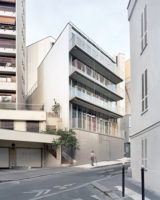Jardim Edite Social Housing
Staying Put and Moving Up.












Architects & Firms
Sao Paulo
When the Jardim Edite favela was scheduled for demolition by S'o Paulo's city authorities, most of its 800 families had little expectation that they would be allowed to remain in their neighborhood. Their shacks were located at the point where the corporate towers of Avenida Berrini meet the new luxury condos sprouting up along Avenida 'gua Espraiada, a hotspot of the real-estate boom that has gripped South America's largest metropolis for the last five years.
So sure were they of being relocated to the city's periphery that most residents accepted meager government help to move to grim public-housing projects hours away from their jobs serving the needs of Berrini's office workers. But for the lucky 252 families who held on, the city is now putting the finishing touches on a development that will rehouse them on the site of their old slum.
The land on which the favela sat was declared a Special Social Interest Zone by the city, so it could not be turned over to the market. S'o Paulo architects MMBB and H+F, in a joint venture, have transformed the favela into the Jardim Edite development, three 17-story poured-in-place-concrete towers alongside two five-story blocks. With a budget constrained by law, the spare complex sits humbly alongside its taller, brasher neighbors. Each of the two-bedroom units is just 540 square feet, the maximum size allowed for social housing.
In the wake of decades of zoning laws that contributed to the construction of a socially and functionally segregated city, Jardim Edite is part of a new generation of developments reminiscent of the more integrated neighborhoods once found around S'o Paulo's deteriorated downtown'an arrangement that is not without challenges. 'How do we avoid turning Jardim Edite into that terrible word'a ghetto?' asks MMBB's Marta Moreira. The solution was to install a city-owned clinic, day-care center, and catering school on the ground floor, therefore linking the building to the wider fabric of the area and holding authorities responsible for the upkeep of the surrounding public space.
The architects have eased the transition from the intensely communal life of the favela into a more formal housing environment by creating interconnecting terraces and wide exterior halls for outside living and gatherings. And they have increased the sense of space inside with smart storage solutions and generous horizontal bands of fenestration.
The cheap public financing provided (families pay about $52 a month on a 30-year mortgage, or $35 per square foot, compared with local prices as high as $470 per square foot) contains anti-flipping clauses, lest the units attract Berrini's corporate workers. But the designers have built in additional safeguards. The building has none of the extras increasingly taken for granted by the middle class'no pool or brick pizza ovens on spacious verandas. Most important, the project lacks parking'the ultimate disincentive in this car-obsessed city.
At first glance Jardim Edite might not seem revolutionary. 'But for us it is a laboratory for investigating ideas for the kind of city we want to build here in S'o Paulo,' says H+F's Eduardo Ferroni. For residents it is an unqualified success. 'We were afraid we would be brought to the end of the world,' says Glaide Jane Barbosa Costa. 'But now we get to stay in our neighborhood. It makes us feel valued.'
Tom Hennigan is the South America correspondent of the Irish Times, based in S'o Paulo.
Completion Date: ~2013 July
Gross square footage: 25.714 m2
Total construction cost: R$ 55.296.763,53
PeopleOwner: Architect: H+F Personnel in architect's firm who should receive special credit: Team: Engineer(s): Executive Project: Consultant(s): Executive Project: Fundantions: Executive Project: Survey: Hidraulic and Eletric Instalations: General contractor: Managing company: Photographer(s): André Rodrigues Costa, MMBB arquitetos archive. CAD system, project management, or other software used: AutoCAD |
ProductsStructural system Exterior cladding Windows Doors Wood doors: Conveyance Plumbing: |








